MGNT110 Autumn 2021: Uber and Netflix Competitive Advantage
VerifiedAdded on 2022/12/01
|8
|1964
|427
Report
AI Summary
This report analyzes the competitive forces affecting Uber and Netflix, utilizing Porter’s Five Forces model to assess industry competition, similarities, and differences. It examines the impact of these forces on each company, considering factors like industry rivalry, the threat of new entrants and substitutes, and the bargaining power of suppliers and customers. Furthermore, the report discusses the business strategies both companies should pursue to maintain their competitive advantage in the post-COVID-19 era, focusing on differentiation, cost, and focus strategies. The analysis highlights the need for strategic adaptation in a changing global market, emphasizing how these strategies can ensure business success and growth. The report concludes by summarizing the key findings and recommendations, emphasizing the importance of strategic planning in a competitive landscape.
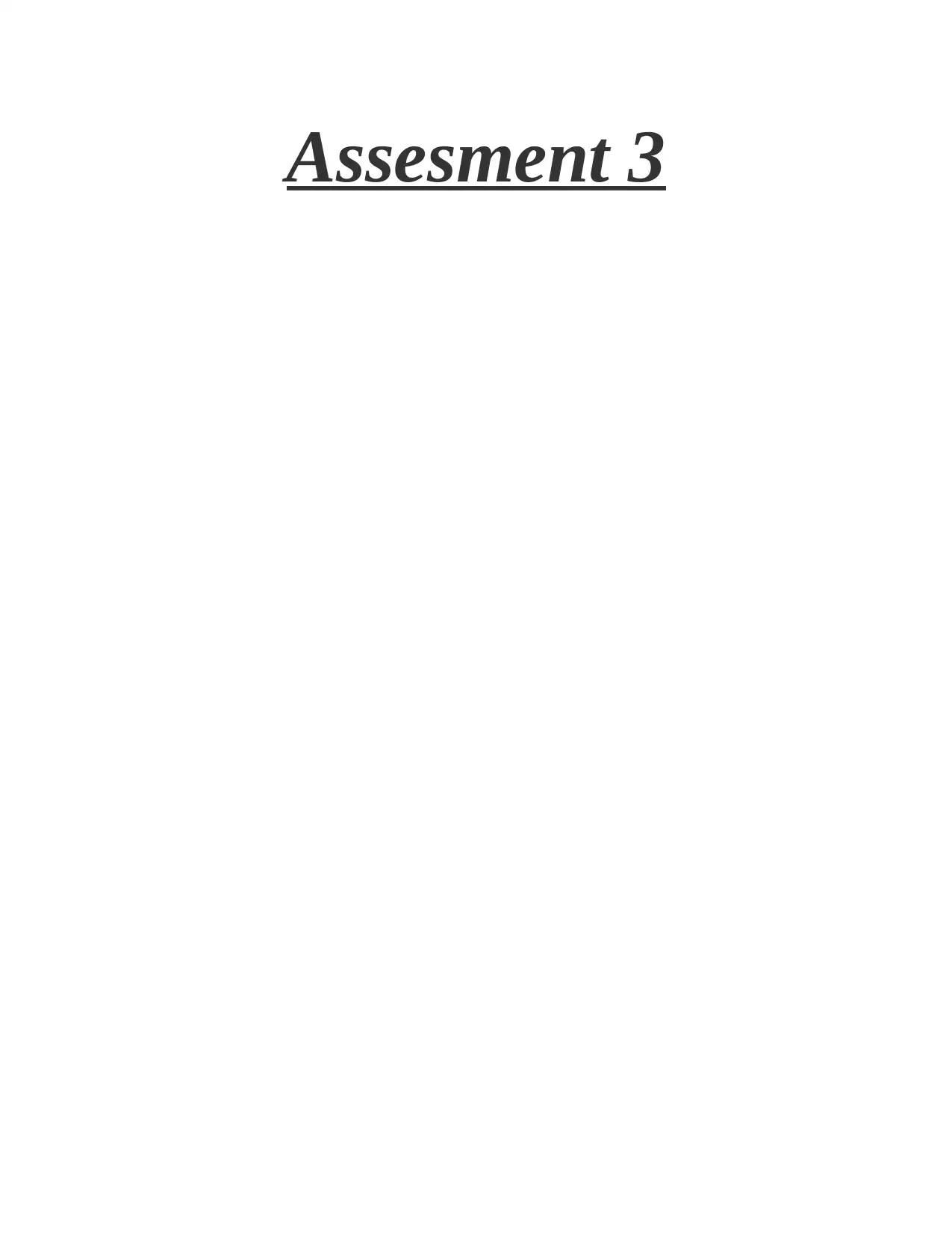
Assesment 3
Paraphrase This Document
Need a fresh take? Get an instant paraphrase of this document with our AI Paraphraser
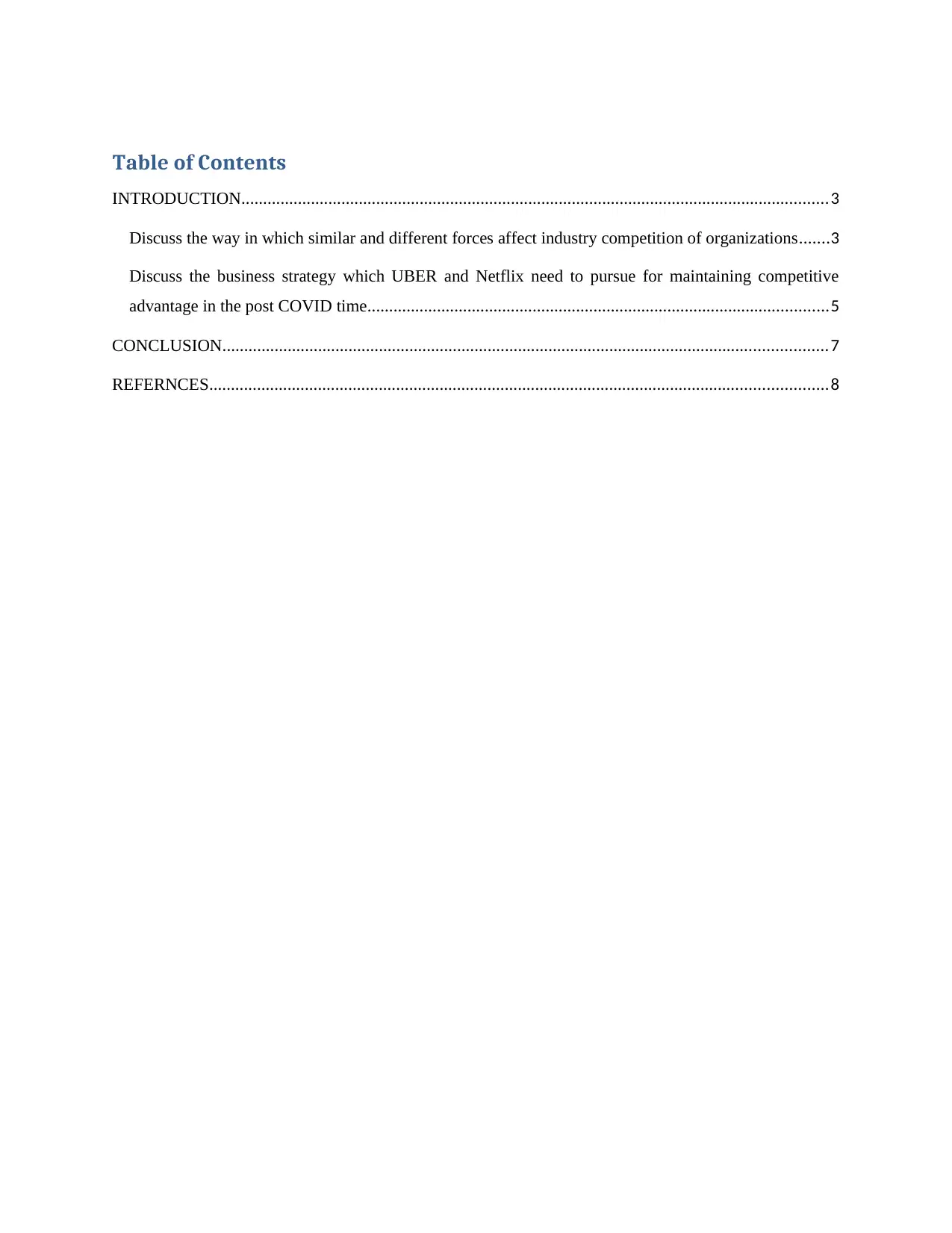
Table of Contents
INTRODUCTION.......................................................................................................................................3
Discuss the way in which similar and different forces affect industry competition of organizations.......3
Discuss the business strategy which UBER and Netflix need to pursue for maintaining competitive
advantage in the post COVID time..........................................................................................................5
CONCLUSION...........................................................................................................................................7
REFERNCES..............................................................................................................................................8
INTRODUCTION.......................................................................................................................................3
Discuss the way in which similar and different forces affect industry competition of organizations.......3
Discuss the business strategy which UBER and Netflix need to pursue for maintaining competitive
advantage in the post COVID time..........................................................................................................5
CONCLUSION...........................................................................................................................................7
REFERNCES..............................................................................................................................................8
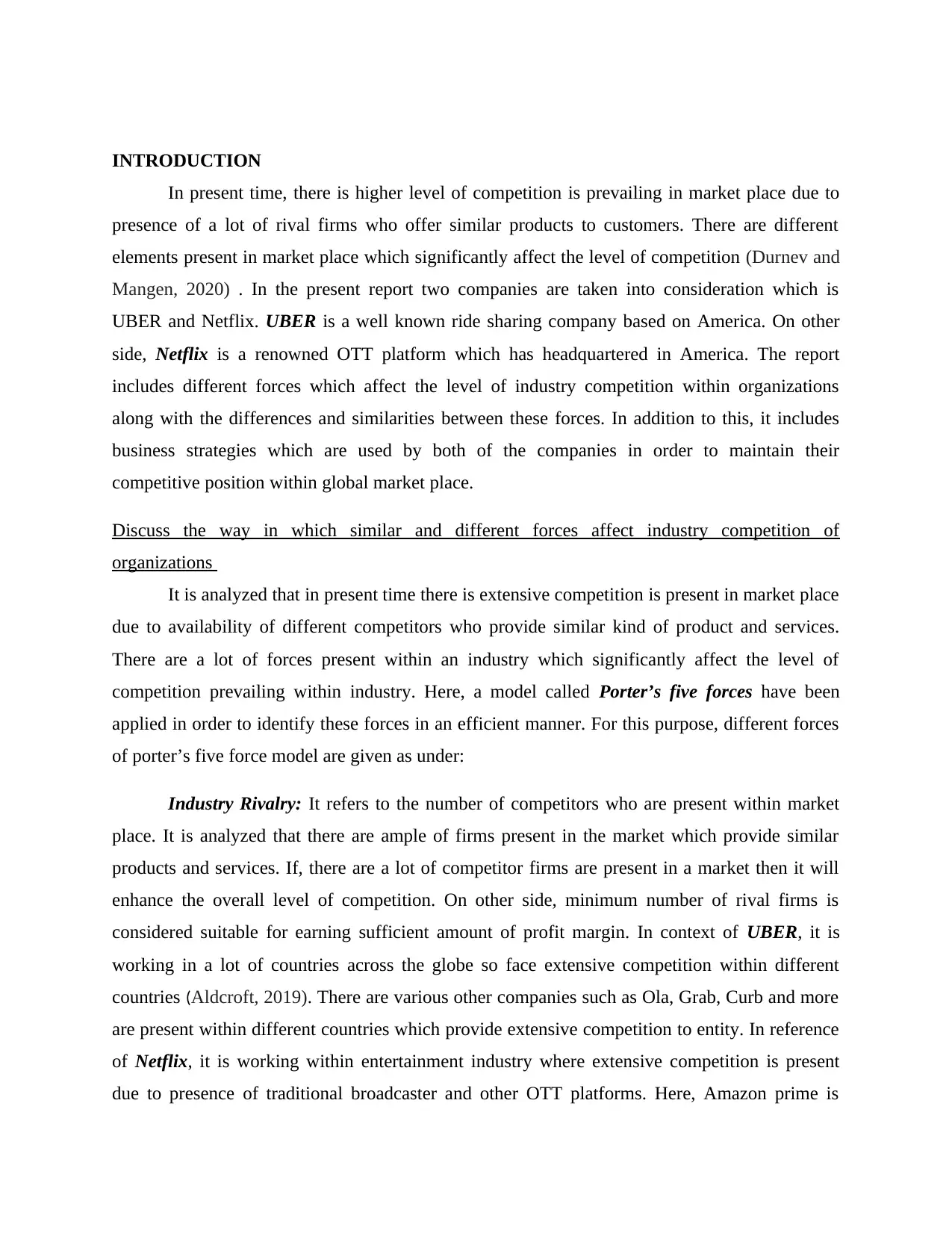
INTRODUCTION
In present time, there is higher level of competition is prevailing in market place due to
presence of a lot of rival firms who offer similar products to customers. There are different
elements present in market place which significantly affect the level of competition (Durnev and
Mangen, 2020) . In the present report two companies are taken into consideration which is
UBER and Netflix. UBER is a well known ride sharing company based on America. On other
side, Netflix is a renowned OTT platform which has headquartered in America. The report
includes different forces which affect the level of industry competition within organizations
along with the differences and similarities between these forces. In addition to this, it includes
business strategies which are used by both of the companies in order to maintain their
competitive position within global market place.
Discuss the way in which similar and different forces affect industry competition of
organizations
It is analyzed that in present time there is extensive competition is present in market place
due to availability of different competitors who provide similar kind of product and services.
There are a lot of forces present within an industry which significantly affect the level of
competition prevailing within industry. Here, a model called Porter’s five forces have been
applied in order to identify these forces in an efficient manner. For this purpose, different forces
of porter’s five force model are given as under:
Industry Rivalry: It refers to the number of competitors who are present within market
place. It is analyzed that there are ample of firms present in the market which provide similar
products and services. If, there are a lot of competitor firms are present in a market then it will
enhance the overall level of competition. On other side, minimum number of rival firms is
considered suitable for earning sufficient amount of profit margin. In context of UBER, it is
working in a lot of countries across the globe so face extensive competition within different
countries (Aldcroft, 2019). There are various other companies such as Ola, Grab, Curb and more
are present within different countries which provide extensive competition to entity. In reference
of Netflix, it is working within entertainment industry where extensive competition is present
due to presence of traditional broadcaster and other OTT platforms. Here, Amazon prime is
In present time, there is higher level of competition is prevailing in market place due to
presence of a lot of rival firms who offer similar products to customers. There are different
elements present in market place which significantly affect the level of competition (Durnev and
Mangen, 2020) . In the present report two companies are taken into consideration which is
UBER and Netflix. UBER is a well known ride sharing company based on America. On other
side, Netflix is a renowned OTT platform which has headquartered in America. The report
includes different forces which affect the level of industry competition within organizations
along with the differences and similarities between these forces. In addition to this, it includes
business strategies which are used by both of the companies in order to maintain their
competitive position within global market place.
Discuss the way in which similar and different forces affect industry competition of
organizations
It is analyzed that in present time there is extensive competition is present in market place
due to availability of different competitors who provide similar kind of product and services.
There are a lot of forces present within an industry which significantly affect the level of
competition prevailing within industry. Here, a model called Porter’s five forces have been
applied in order to identify these forces in an efficient manner. For this purpose, different forces
of porter’s five force model are given as under:
Industry Rivalry: It refers to the number of competitors who are present within market
place. It is analyzed that there are ample of firms present in the market which provide similar
products and services. If, there are a lot of competitor firms are present in a market then it will
enhance the overall level of competition. On other side, minimum number of rival firms is
considered suitable for earning sufficient amount of profit margin. In context of UBER, it is
working in a lot of countries across the globe so face extensive competition within different
countries (Aldcroft, 2019). There are various other companies such as Ola, Grab, Curb and more
are present within different countries which provide extensive competition to entity. In reference
of Netflix, it is working within entertainment industry where extensive competition is present
due to presence of traditional broadcaster and other OTT platforms. Here, Amazon prime is
⊘ This is a preview!⊘
Do you want full access?
Subscribe today to unlock all pages.

Trusted by 1+ million students worldwide
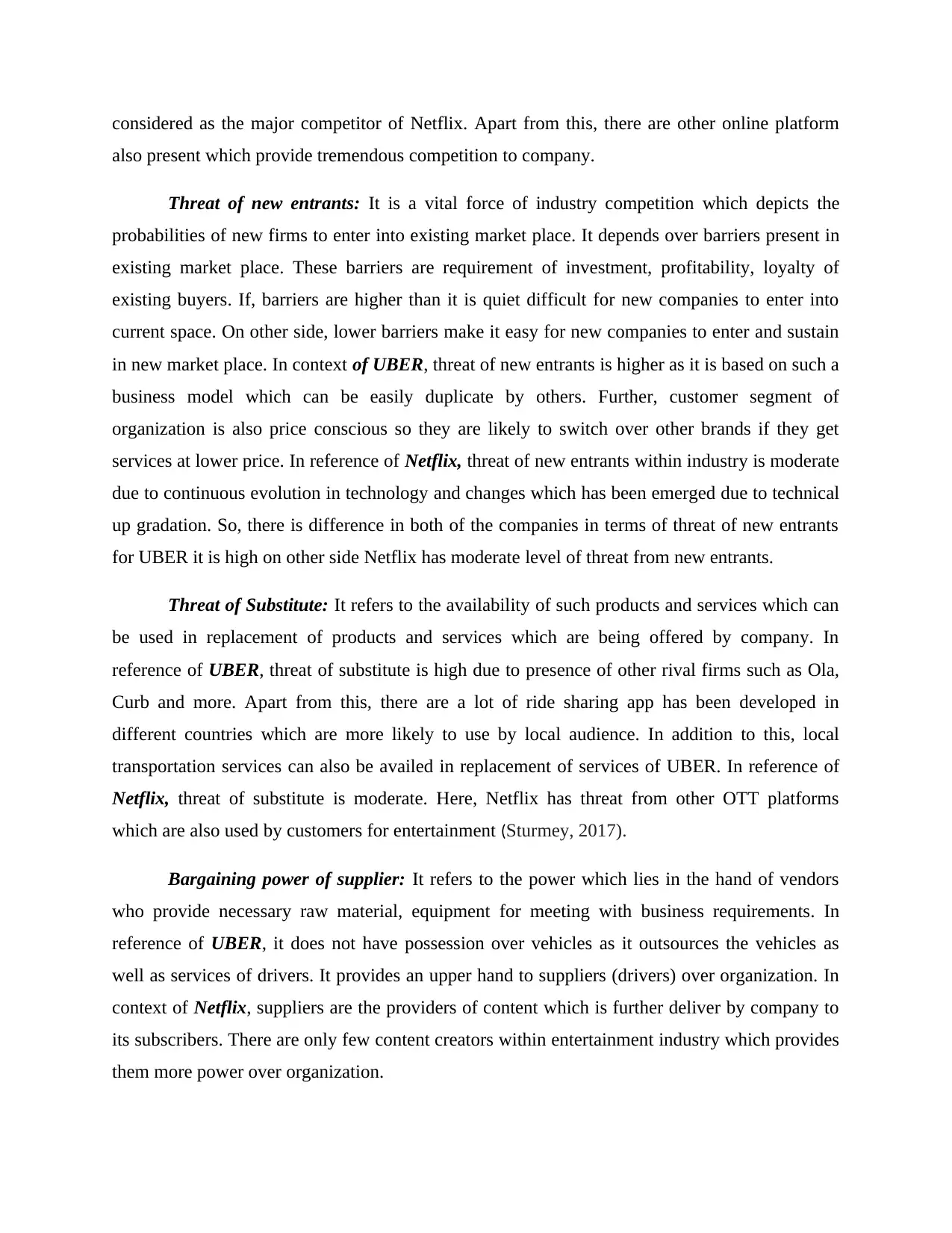
considered as the major competitor of Netflix. Apart from this, there are other online platform
also present which provide tremendous competition to company.
Threat of new entrants: It is a vital force of industry competition which depicts the
probabilities of new firms to enter into existing market place. It depends over barriers present in
existing market place. These barriers are requirement of investment, profitability, loyalty of
existing buyers. If, barriers are higher than it is quiet difficult for new companies to enter into
current space. On other side, lower barriers make it easy for new companies to enter and sustain
in new market place. In context of UBER, threat of new entrants is higher as it is based on such a
business model which can be easily duplicate by others. Further, customer segment of
organization is also price conscious so they are likely to switch over other brands if they get
services at lower price. In reference of Netflix, threat of new entrants within industry is moderate
due to continuous evolution in technology and changes which has been emerged due to technical
up gradation. So, there is difference in both of the companies in terms of threat of new entrants
for UBER it is high on other side Netflix has moderate level of threat from new entrants.
Threat of Substitute: It refers to the availability of such products and services which can
be used in replacement of products and services which are being offered by company. In
reference of UBER, threat of substitute is high due to presence of other rival firms such as Ola,
Curb and more. Apart from this, there are a lot of ride sharing app has been developed in
different countries which are more likely to use by local audience. In addition to this, local
transportation services can also be availed in replacement of services of UBER. In reference of
Netflix, threat of substitute is moderate. Here, Netflix has threat from other OTT platforms
which are also used by customers for entertainment (Sturmey, 2017).
Bargaining power of supplier: It refers to the power which lies in the hand of vendors
who provide necessary raw material, equipment for meeting with business requirements. In
reference of UBER, it does not have possession over vehicles as it outsources the vehicles as
well as services of drivers. It provides an upper hand to suppliers (drivers) over organization. In
context of Netflix, suppliers are the providers of content which is further deliver by company to
its subscribers. There are only few content creators within entertainment industry which provides
them more power over organization.
also present which provide tremendous competition to company.
Threat of new entrants: It is a vital force of industry competition which depicts the
probabilities of new firms to enter into existing market place. It depends over barriers present in
existing market place. These barriers are requirement of investment, profitability, loyalty of
existing buyers. If, barriers are higher than it is quiet difficult for new companies to enter into
current space. On other side, lower barriers make it easy for new companies to enter and sustain
in new market place. In context of UBER, threat of new entrants is higher as it is based on such a
business model which can be easily duplicate by others. Further, customer segment of
organization is also price conscious so they are likely to switch over other brands if they get
services at lower price. In reference of Netflix, threat of new entrants within industry is moderate
due to continuous evolution in technology and changes which has been emerged due to technical
up gradation. So, there is difference in both of the companies in terms of threat of new entrants
for UBER it is high on other side Netflix has moderate level of threat from new entrants.
Threat of Substitute: It refers to the availability of such products and services which can
be used in replacement of products and services which are being offered by company. In
reference of UBER, threat of substitute is high due to presence of other rival firms such as Ola,
Curb and more. Apart from this, there are a lot of ride sharing app has been developed in
different countries which are more likely to use by local audience. In addition to this, local
transportation services can also be availed in replacement of services of UBER. In reference of
Netflix, threat of substitute is moderate. Here, Netflix has threat from other OTT platforms
which are also used by customers for entertainment (Sturmey, 2017).
Bargaining power of supplier: It refers to the power which lies in the hand of vendors
who provide necessary raw material, equipment for meeting with business requirements. In
reference of UBER, it does not have possession over vehicles as it outsources the vehicles as
well as services of drivers. It provides an upper hand to suppliers (drivers) over organization. In
context of Netflix, suppliers are the providers of content which is further deliver by company to
its subscribers. There are only few content creators within entertainment industry which provides
them more power over organization.
Paraphrase This Document
Need a fresh take? Get an instant paraphrase of this document with our AI Paraphraser
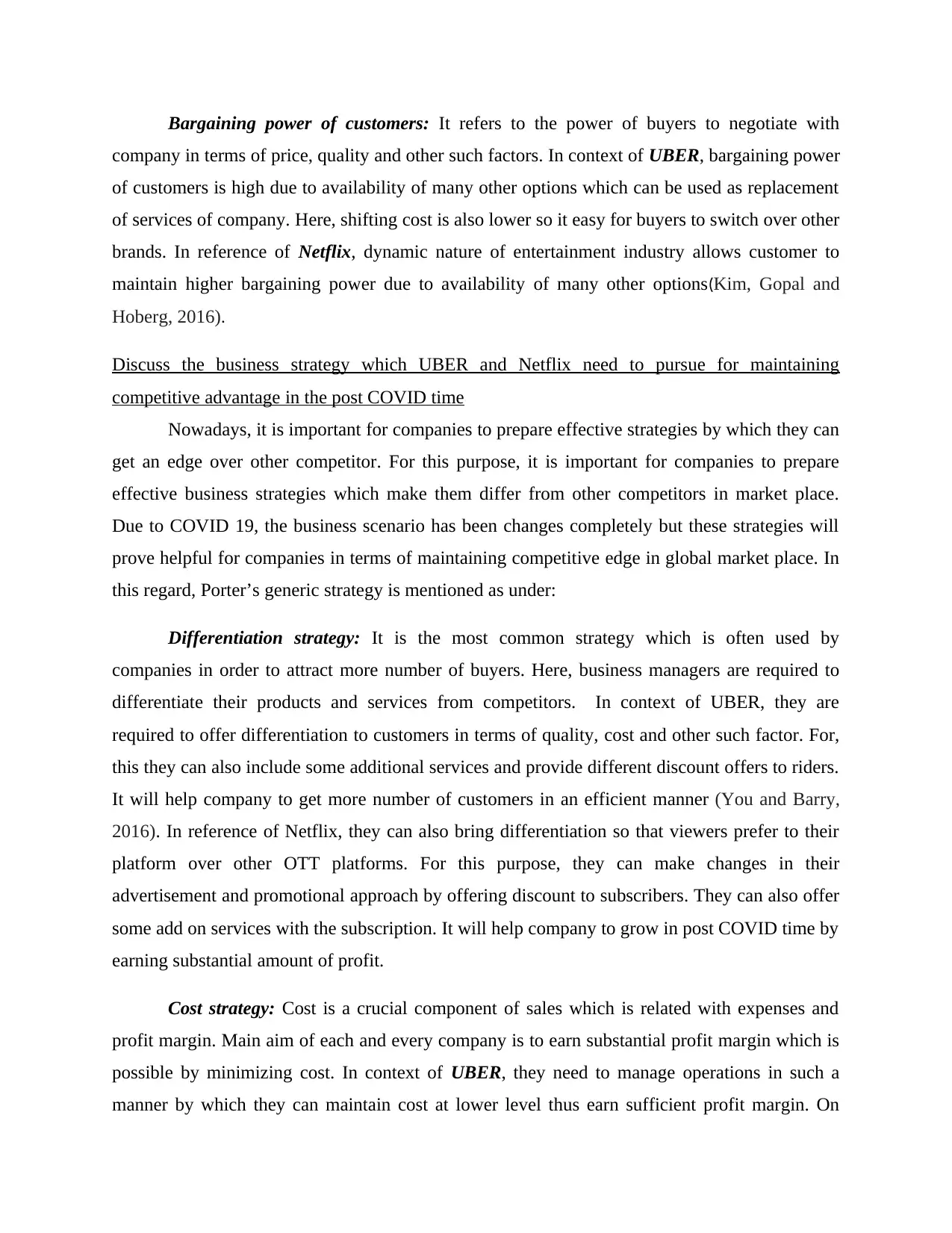
Bargaining power of customers: It refers to the power of buyers to negotiate with
company in terms of price, quality and other such factors. In context of UBER, bargaining power
of customers is high due to availability of many other options which can be used as replacement
of services of company. Here, shifting cost is also lower so it easy for buyers to switch over other
brands. In reference of Netflix, dynamic nature of entertainment industry allows customer to
maintain higher bargaining power due to availability of many other options(Kim, Gopal and
Hoberg, 2016).
Discuss the business strategy which UBER and Netflix need to pursue for maintaining
competitive advantage in the post COVID time
Nowadays, it is important for companies to prepare effective strategies by which they can
get an edge over other competitor. For this purpose, it is important for companies to prepare
effective business strategies which make them differ from other competitors in market place.
Due to COVID 19, the business scenario has been changes completely but these strategies will
prove helpful for companies in terms of maintaining competitive edge in global market place. In
this regard, Porter’s generic strategy is mentioned as under:
Differentiation strategy: It is the most common strategy which is often used by
companies in order to attract more number of buyers. Here, business managers are required to
differentiate their products and services from competitors. In context of UBER, they are
required to offer differentiation to customers in terms of quality, cost and other such factor. For,
this they can also include some additional services and provide different discount offers to riders.
It will help company to get more number of customers in an efficient manner (You and Barry,
2016). In reference of Netflix, they can also bring differentiation so that viewers prefer to their
platform over other OTT platforms. For this purpose, they can make changes in their
advertisement and promotional approach by offering discount to subscribers. They can also offer
some add on services with the subscription. It will help company to grow in post COVID time by
earning substantial amount of profit.
Cost strategy: Cost is a crucial component of sales which is related with expenses and
profit margin. Main aim of each and every company is to earn substantial profit margin which is
possible by minimizing cost. In context of UBER, they need to manage operations in such a
manner by which they can maintain cost at lower level thus earn sufficient profit margin. On
company in terms of price, quality and other such factors. In context of UBER, bargaining power
of customers is high due to availability of many other options which can be used as replacement
of services of company. Here, shifting cost is also lower so it easy for buyers to switch over other
brands. In reference of Netflix, dynamic nature of entertainment industry allows customer to
maintain higher bargaining power due to availability of many other options(Kim, Gopal and
Hoberg, 2016).
Discuss the business strategy which UBER and Netflix need to pursue for maintaining
competitive advantage in the post COVID time
Nowadays, it is important for companies to prepare effective strategies by which they can
get an edge over other competitor. For this purpose, it is important for companies to prepare
effective business strategies which make them differ from other competitors in market place.
Due to COVID 19, the business scenario has been changes completely but these strategies will
prove helpful for companies in terms of maintaining competitive edge in global market place. In
this regard, Porter’s generic strategy is mentioned as under:
Differentiation strategy: It is the most common strategy which is often used by
companies in order to attract more number of buyers. Here, business managers are required to
differentiate their products and services from competitors. In context of UBER, they are
required to offer differentiation to customers in terms of quality, cost and other such factor. For,
this they can also include some additional services and provide different discount offers to riders.
It will help company to get more number of customers in an efficient manner (You and Barry,
2016). In reference of Netflix, they can also bring differentiation so that viewers prefer to their
platform over other OTT platforms. For this purpose, they can make changes in their
advertisement and promotional approach by offering discount to subscribers. They can also offer
some add on services with the subscription. It will help company to grow in post COVID time by
earning substantial amount of profit.
Cost strategy: Cost is a crucial component of sales which is related with expenses and
profit margin. Main aim of each and every company is to earn substantial profit margin which is
possible by minimizing cost. In context of UBER, they need to manage operations in such a
manner by which they can maintain cost at lower level thus earn sufficient profit margin. On
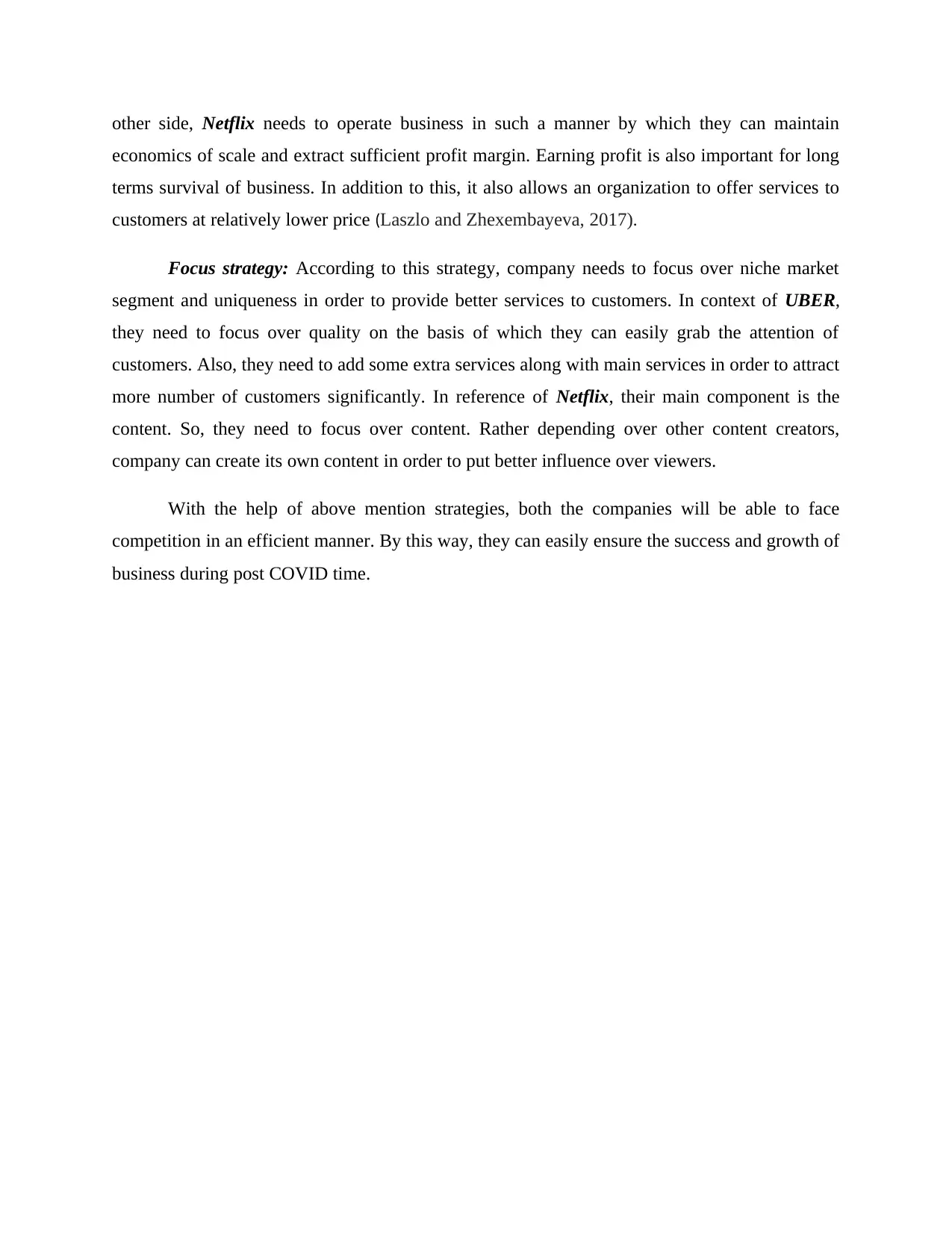
other side, Netflix needs to operate business in such a manner by which they can maintain
economics of scale and extract sufficient profit margin. Earning profit is also important for long
terms survival of business. In addition to this, it also allows an organization to offer services to
customers at relatively lower price (Laszlo and Zhexembayeva, 2017).
Focus strategy: According to this strategy, company needs to focus over niche market
segment and uniqueness in order to provide better services to customers. In context of UBER,
they need to focus over quality on the basis of which they can easily grab the attention of
customers. Also, they need to add some extra services along with main services in order to attract
more number of customers significantly. In reference of Netflix, their main component is the
content. So, they need to focus over content. Rather depending over other content creators,
company can create its own content in order to put better influence over viewers.
With the help of above mention strategies, both the companies will be able to face
competition in an efficient manner. By this way, they can easily ensure the success and growth of
business during post COVID time.
economics of scale and extract sufficient profit margin. Earning profit is also important for long
terms survival of business. In addition to this, it also allows an organization to offer services to
customers at relatively lower price (Laszlo and Zhexembayeva, 2017).
Focus strategy: According to this strategy, company needs to focus over niche market
segment and uniqueness in order to provide better services to customers. In context of UBER,
they need to focus over quality on the basis of which they can easily grab the attention of
customers. Also, they need to add some extra services along with main services in order to attract
more number of customers significantly. In reference of Netflix, their main component is the
content. So, they need to focus over content. Rather depending over other content creators,
company can create its own content in order to put better influence over viewers.
With the help of above mention strategies, both the companies will be able to face
competition in an efficient manner. By this way, they can easily ensure the success and growth of
business during post COVID time.
⊘ This is a preview!⊘
Do you want full access?
Subscribe today to unlock all pages.

Trusted by 1+ million students worldwide
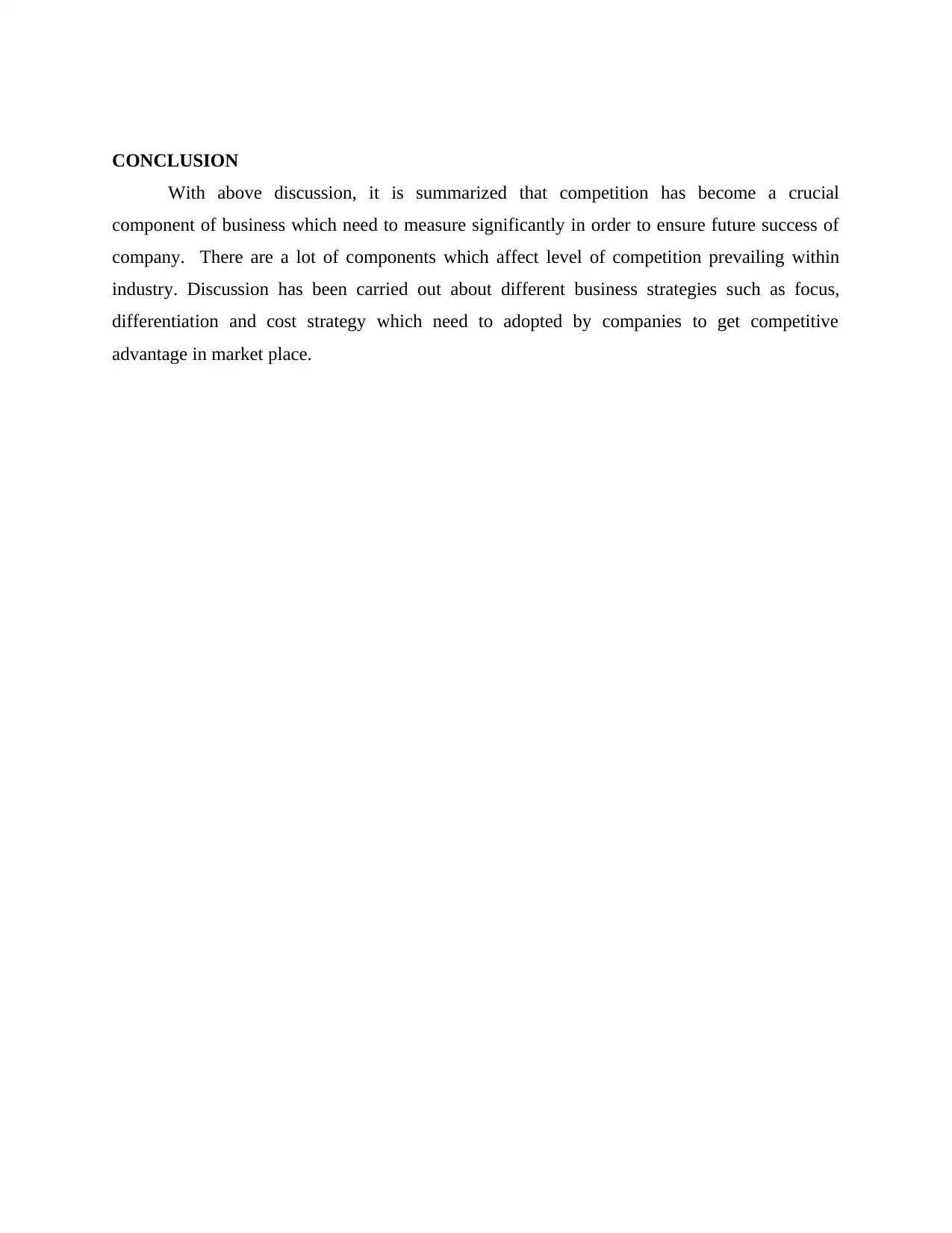
CONCLUSION
With above discussion, it is summarized that competition has become a crucial
component of business which need to measure significantly in order to ensure future success of
company. There are a lot of components which affect level of competition prevailing within
industry. Discussion has been carried out about different business strategies such as focus,
differentiation and cost strategy which need to adopted by companies to get competitive
advantage in market place.
With above discussion, it is summarized that competition has become a crucial
component of business which need to measure significantly in order to ensure future success of
company. There are a lot of components which affect level of competition prevailing within
industry. Discussion has been carried out about different business strategies such as focus,
differentiation and cost strategy which need to adopted by companies to get competitive
advantage in market place.
Paraphrase This Document
Need a fresh take? Get an instant paraphrase of this document with our AI Paraphraser
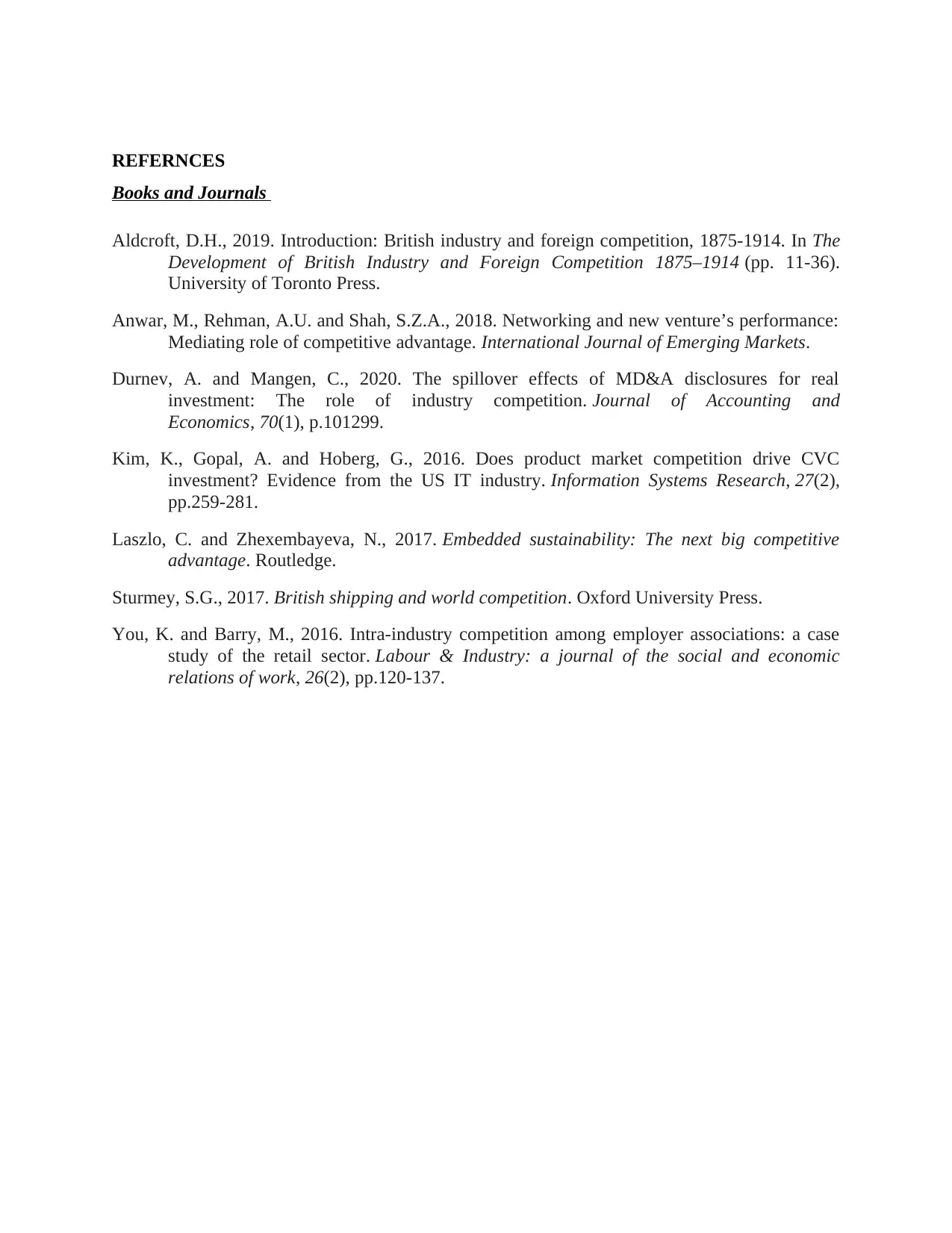
REFERNCES
Books and Journals
Aldcroft, D.H., 2019. Introduction: British industry and foreign competition, 1875-1914. In The
Development of British Industry and Foreign Competition 1875–1914 (pp. 11-36).
University of Toronto Press.
Anwar, M., Rehman, A.U. and Shah, S.Z.A., 2018. Networking and new venture’s performance:
Mediating role of competitive advantage. International Journal of Emerging Markets.
Durnev, A. and Mangen, C., 2020. The spillover effects of MD&A disclosures for real
investment: The role of industry competition. Journal of Accounting and
Economics, 70(1), p.101299.
Kim, K., Gopal, A. and Hoberg, G., 2016. Does product market competition drive CVC
investment? Evidence from the US IT industry. Information Systems Research, 27(2),
pp.259-281.
Laszlo, C. and Zhexembayeva, N., 2017. Embedded sustainability: The next big competitive
advantage. Routledge.
Sturmey, S.G., 2017. British shipping and world competition. Oxford University Press.
You, K. and Barry, M., 2016. Intra-industry competition among employer associations: a case
study of the retail sector. Labour & Industry: a journal of the social and economic
relations of work, 26(2), pp.120-137.
Books and Journals
Aldcroft, D.H., 2019. Introduction: British industry and foreign competition, 1875-1914. In The
Development of British Industry and Foreign Competition 1875–1914 (pp. 11-36).
University of Toronto Press.
Anwar, M., Rehman, A.U. and Shah, S.Z.A., 2018. Networking and new venture’s performance:
Mediating role of competitive advantage. International Journal of Emerging Markets.
Durnev, A. and Mangen, C., 2020. The spillover effects of MD&A disclosures for real
investment: The role of industry competition. Journal of Accounting and
Economics, 70(1), p.101299.
Kim, K., Gopal, A. and Hoberg, G., 2016. Does product market competition drive CVC
investment? Evidence from the US IT industry. Information Systems Research, 27(2),
pp.259-281.
Laszlo, C. and Zhexembayeva, N., 2017. Embedded sustainability: The next big competitive
advantage. Routledge.
Sturmey, S.G., 2017. British shipping and world competition. Oxford University Press.
You, K. and Barry, M., 2016. Intra-industry competition among employer associations: a case
study of the retail sector. Labour & Industry: a journal of the social and economic
relations of work, 26(2), pp.120-137.
1 out of 8
Related Documents
Your All-in-One AI-Powered Toolkit for Academic Success.
+13062052269
info@desklib.com
Available 24*7 on WhatsApp / Email
![[object Object]](/_next/static/media/star-bottom.7253800d.svg)
Unlock your academic potential
Copyright © 2020–2026 A2Z Services. All Rights Reserved. Developed and managed by ZUCOL.





